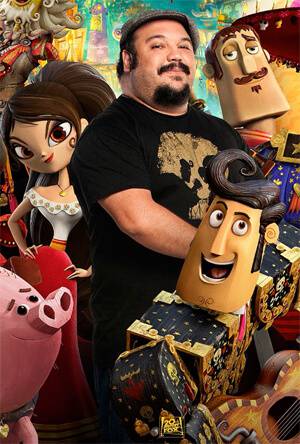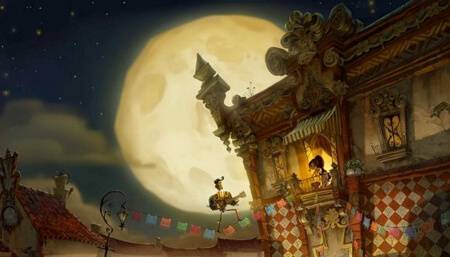Interview with Jorge Gutiérrez, director of ‘The Book of Life’

Jorge Gutiérrez
The visually rich world of Reel FX‘s newest feature film The Book of Life opens in UK cinemas today, midst a gleefully saturated and dynamic advertising campaign which has screamed out from bus stops and billboards across the nation. A surprising left turn after the studio’s far more traditional 2013 offering Free Birds, The Book of Life is a tale of love, family, culture and set against a prevailing Dia de los Muertos-themed backdrop. Director Jorge Gutiérrez‘s strong enthusiasm for Mexican culture is evidenced in prior projects, such as El Macho and the Annie/Emmy award-winning Nickelodeon TV series El Tigre: The Adventures of Manny Rivera. Skwigly writer Julia Young leapt at the opportunity to talk to Jorge about his first experience as a feature film director.
How much of the film was inspired by traditional stories?
It was definitely very much inspired by the stories I heard from my family growing up; From my grandfather and the way he had to compete to win the love of my grandmother, the way my father had to compete to win the love of my Mom – and then all the stuff I had to do to win the love of my wife! Also the movie’s very much inspired by the great myth of Orpheus, a musician going to the underworld for his beloved, so while it takes place in Mexico, it’s very much inspired by a lot of myths and folk tales from all over the world.
It sounds very personal to you as well, I suppose a big part of it was bringing some Mexican culture into American cinema…
Absolutely, when I grew up I honestly never saw ‘myself’ up on the screen. I kept wondering when we were gonna show up, and I kind of made it my mission to try to showcase my culture.
That’s absolutely fantastic. How much of the culture in the film is actually based on real Mexican culture?
A lot of the mythology of the ancient Gods is all kind of made-up! I always say this is not a documentary, this is a magic version of the Mexico that I remember as a kid. I see Mexico with eyes of nostalgia and love. This is my fantasy version of what I imagined it was like.
The wonderful style of the film is so original and refreshing. Is that also to do with the imaginative nature of it?
Yes, absolutely, the look of the film is very much inspired by Latin American and Mexican folk art. This is art which is not very expensive, it’s the kind of art that you buy in the market when you buy a watermelon; A little sculpture you take home for the kids to play with, which has a lot of imperfections that, to me, make it really charming. So our movie is very much a love letter to all those things. All the characters are made out of wood and metal and to me it was like a Mexican Pinocchio/Toy Story.
Was the decision to use that style an immediately obvious choice or did it happen in the concept stage?
No, it started in the script, my wife Sandra (Equihua, co-creator of El Tigre) designed all the girls, I designed all the male characters and so from the beginning I always envisioned this magical world of wooden puppets – it was also a good way to be able to get away from bullets, guns, blood and all those things, by keeping it really magical.

The Book of Life (20th Century Fox)
When I saw the posters for the film I did think “Oh that’s gonna be a challenge”, but the animation was beautifully fluid. How did the animators find animating those sort of ‘blocky’ characters?
In the beginning it was really hard, a lot of the animators were really angry at me! The way they’re built, they’re not naturally designed for animation, so animators worked extra hard to make it feel smooth and unique. I think by having these characters be so different it made them animate in ways that they weren’t used to. We found a new, more unique way to tell a story with these guys, because what I kept saying to them was “These characters are very used to their proportions, so they’ve figured out how to move in a certain way”. It’s like if you have three legs in real life, you’d figure out how to get around like that.
So this was your first time directing a feature film, how did you find it?
Well, I always said if this is the last one I get to direct I’m gonna put everything in it – I might not get another chance! It was really, really hard but at the same time it was a dream come true. It was like a birthday party every day…but then some days I was the piñata and everybody got to hit me!
So how was it working with the team at Reel FX and 20th Century Fox?
Reel FX is a young studio and they took a chance on me, so I feel like I owe them everything. Then 20th Century Fox as the co-financiers and distributors, they liked what we were doing and again took a big chance. Our movie’s very different, it doesn’t look or sound like a regular animated movie, so for these big studios to support me and support our movie is a dream come true.
Did you ever feel overwhelmed, directing such a packed film when it comes to story content?
(Laughs) Every day! I have perhaps too many ideas. I had to try to put everything in the movie and Guillermo del Toro, our producer, was really good at making sure I didn’t overdo it. Without Guillermo this movie would not have gotten made.
Did you enjoy collaborating with him?
Oh yeah, I feel like I was little kid dressed up like Robin playing in the yard, and then the Batmobile pulled up, the door opened and Batman said “Get in! We’re gonna go fight crime”! That’s what it felt like working with Guillermo, he’s my hero, someone I’ve always admired.
I’m glad to hear it! How involved were you in the voice casting, I wondered?
Well, I wrote the film for Diego Luna originally, then from that point forward it was just a matter of chemistry. I knew Zoe Saldana and Diego had played a couple in the Spielberg movie The Terminal, they didn’t speak a single line to each other but I could tell they had this beautiful chemistry. Then the third member of the love triangle was Channing Tatum, I wanted Joaquín to be voiced by someone every man admired and every woman wanted to hang out with. I honestly didn’t think he’d say yes, but when I pitched him the movie he fell in love with it, and then after the pitch took me aside and, very serious, said “Jorge, you know I’m not Mexican, right?” I said “Channing, even though this movie takes place in Mexico I want the voice cast to be from all over the world”. This is a universal story, and who better to personify this giant superhero of Latin America? I told him “You’re gonna be Captain Latin America in the movie”! And he jumped in and we had a blast!

The Book of Life (20th Century Fox)
Guillermo always says “In order to be universal you need to be specific”, so I looked at Amélie and City of God from Brazil, Love Actually, these movies are very unique to their countries but they’re super universal.
And how did you work out the ‘mythology’ of the world? How did you come to the idea of the Land of the Remembered and the Land of the Forgotten?
Well, I’ve always loved the idea that as long as we tell the stories and remember those who came before us, they’re with us. I figured they’d live in a place created by memory, nostalgia and the love that we have for them, so that was the inspiration for the Land of the Remembered, this land of memories. Land of the Forgotton is the opposite, when you forget a toy, or you forget a friend or you don’t talk about them anymore, that world is devoid of colour and devoid of music. There’s nothing worse than forgetting somebody.
This film seems so personal to you, both with the Mexican culture and with, as you say, the story coming from your own personal experience. Do you think [making a film] will ever be the same again?
Y’know, all the stuff I’ve ever done, it’s always based on my experiences and things that have happened to my family, and I have a really big family (laughs) so there’s a lot of stories! Obviously I will always make things that are a love letter to Mexico, so I have a lot more tales to tell.
The Book of Life opens in UK cinemas today. For more information on the film read our review or you can visit the official site at bookoflifemovie.com


